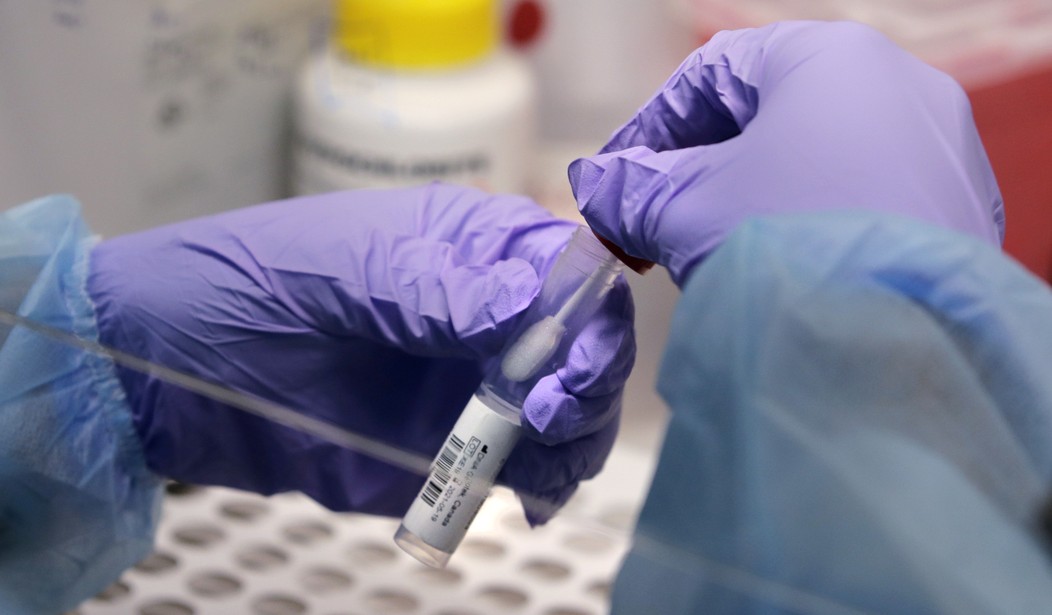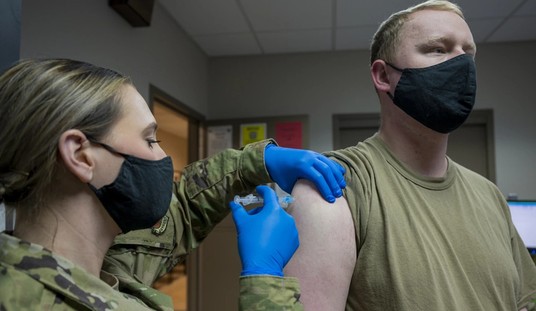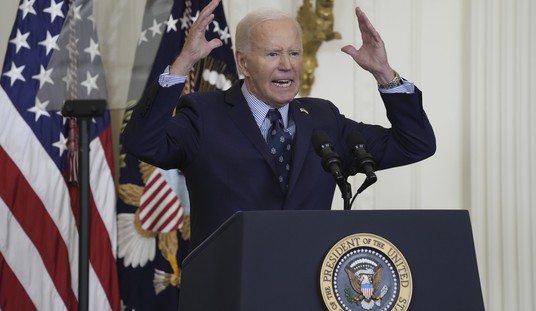The Daily Mail caused a major stir on Monday when it reported that researchers at Boston University had created a COVID strain with “an 80 percent kill rate” in its National Emerging Infectious Disease Laboratories (NEIDL). As the initial reporting explained:
In the new research, which has not been peer-reviewed, a team of researchers from Boston and Florida extracted Omicron’s spike protein — the unique structure that binds to and invades human cells.
It has always been present in the virus but has become more evolved over time. Omicron has dozens of mutations on its spike protein that made it so infectious.
Researchers attached Omicron’s spike to the original wildtype strain that first emerged in Wuhan at the start of the pandemic.
In other words, the researchers took the (more infectious) Omicron variant’s spike protein and combined it with the (more virulent) original Wuhan strain (a/k/a the “Washington strain”) and studied the hybrid’s effect on mice. What the study found was while the mice exposed only to the Omicron variant all survived with fairly mild symptoms, 80 percent of those exposed to the hybrid (dubbed “Omicron-S”) died.
As one might expect, this raised a great deal of concern. At first blush, this would appear to be the very sort of “gain-of-function” research conducted at the Wuhan Institute of Virology that many believe caused the pandemic (the “lab leak theory“).
Reaction was swift, with a number of experts condemning the research and characterizing it as dangerous. Per the Daily Mail,
Professor Shmuel Shapira, a leading scientist in the Israeli Government, said: ‘This should be totally forbidden, it’s playing with fire.’
…
Dr Richard Ebright, a chemist at Rutgers University in New Brunswick, New Jersey, told DailyMail.com that: ‘The research is a clear example of gain of function research.
He added: ‘If we are to avoid a next lab-generated pandemic, it is imperative that oversight of enhanced potential pandemic pathogen research be strengthened.’
The news raised obvious questions, as well: Who was funding this research? Why was it approved, given that gain-of-function research has been restricted in the US since 2014? How secure is this facility? What were they thinking?! (Sorry, that last one is me editorializing a bit.)
In response to the Daily Mail article, Boston University pushed back, characterizing the story as “false and inaccurate.”
“They’ve sensationalized the message, they misrepresent the study and its goals in its entirety,” says Ronald B. Corley, NEIDL director and BU Chobanian & Avedisian School of Medicine chair of microbiology, of the news reports.
The study set out to examine the spike proteins on the SARS-CoV-2 Omicron variant (BA.1). Researchers were interested in comparing the variant with the original virus strain, known as the Washington strain. They wanted to find out if the virus was truly less virulent, says Corley, “simply because it wasn’t infecting the same cells as the initial strain.” They were “interested in what part of the virus dictates how serious of a disease a person will get.”
But Corley says the news reports pulled one line from the paper’s abstract out of context, with the Daily Mail suggesting in its headline that the researchers had created a “deadly Covid strain with an 80 percent kill rate.” The newspaper went on to make a series of other misleading claims, including that the study was “gain of function research,” alleging researchers set out to make a more deadly virus.
Not true, says Corley. And the University’s statement strongly denied it.
Rather, the University contends, this research actually made the Washington strain less deadly.
“The animal model that was used was a particular type of mouse that is highly susceptible, and 80 to 100 percent of the infected mice succumb to disease from the original strain, the so-called Washington strain,” says Corley. “Whereas Omicron causes a very mild disease in these animals.”
Well, yes and no. First, here’s what the actual study says:
The recently identified, globally predominant SARS-CoV-2 Omicron variant (BA.1) is highly transmissible, even in fully vaccinated individuals, and causes attenuated disease compared with other major viral variants recognized to date. The Omicron spike (S) protein, with an unusually large number of mutations, is considered the major driver of these phenotypes. We generated chimeric recombinant SARS-CoV-2 encoding the S gene of Omicron in the backbone of an ancestral SARS-CoV-2 isolate and compared this virus with the naturally circulating Omicron variant. The Omicron S-bearing virus robustly escapes vaccine-induced humoral immunity, mainly due to mutations in the receptor binding motif (RBM), yet unlike naturally occurring Omicron, efficiently replicates in cell lines and primary-like distal lung cells. In K18-hACE2 mice, while Omicron causes mild, non-fatal infection, the Omicron S-carrying virus inflicts severe disease with a mortality rate of 80%. [emphasis added] This indicates that while the vaccine escape of Omicron is defined by mutations in S, major determinants of viral pathogenicity reside outside of S.
So, the “kill rate” of Omicron-S in the test subject mice was 80 percent. Admittedly, that’s less than the (up to) 100 percent mortality (of the mice) attributed to the Washington strain. But if it can be said that adding the Omicron spike protein to the Washington strain made the Washington strain less deadly (from 100 percent to 80 percent), can it not also be said that combining the two made the Omicron spike protein more deadly (from 0 percent to 80 percent)? (I recognize that the spike protein does not act absent the strain, but neither does the strain act absent the spike protein.)
Put another way, what happens when you take a deadly virus strain and combine it with a highly transmissible spike protein? Moreover, what if the experiment had yielded a hybrid with a kill rate greater than or equal to that of the Washington strain? Yes, I have concerns — as I suspect most rational people would.
BU, in its statement, addressed the issue of funding:
Boston University statement on following National Institute of Allergy and Infectious Diseases (NIAID) guidelines: “We fulfilled all required regulatory obligations and protocols. Following NIAID’s guidelines and protocols, we did not have an obligation to disclose this research for two reasons. The experiments reported in this manuscript were carried out with funds from Boston University. NIAID funding was acknowledged because it was used to help develop the tools and platforms that were used in this research; they did not fund this research directly. NIH funding was also acknowledged for a shared instrumentation grant that helped support the pathology studies. We believe that funding streams for tools do not require an obligation to report. Secondly, there was no gain of function with this research. If at any point there was evidence that the research was gaining function, under both NIAID and our own protocols we would immediately stop and report. All research at Boston University, whether funded by NIAID or not, follows this same protocol. We are in continued conversation with NIAID leadership and program officers.”
So…the experiments were funded by the university, and the university received NIAID funding which helped “develop the tools and platforms that were used in this research” and NIH funding of a “shared instrumentation grant that helped support the pathology studies,” but none of those funds paid for the research “directly.” Forgive the OG COVID reference, but this doesn’t quite pass the smell test.
In a subsequent article, the Daily Mail reports:
Public records indicate it was partly paid for using a grant awarded by the National Institute of Allergy and Infectious Diseases (NIAID), one of the federal government’s main research agencies.
As part of any Government-funded research grants, teams have to explain what the money is being used for and how it will benefit the public.
But today, Dr Emily Erbelding, director of NIAID’s division of microbiology and infectious diseases, said the Boston team did not clear the work with the agency.
She claims she only found out the experiments might have involved enhancing a pathogen of pandemic potential after reading reports in the media on Monday.
Dr Erbelding admitted feeling uneasy about the type of research the grants had been used to fund — given the lingering questions about the role of virus manipulation studies and the origins of Covid.
As noted above, the University maintains that this was not, in fact, gain-of-function research, the rationale being that the chimeric virus was less lethal than the original strain, ergo, no function was “gained.” This seemingly employs an “ends justify the means” mentality — it just so happened the hybrid was less lethal, but there was no guarantee of the outcome (which is the whole point of the experimentation — to find out what will happen). As raised previously: What if the resulting chimera hadn’t proved less lethal?
However, as the Mail notes:
There is now a row about whether the study qualifies as gain-of-function.
Dr Richard Ebright, a microbiologist at Rutgers University in New Jersey, today said it was ‘demonstrably false’ and ‘deeply embarrassing’ to suggest otherwise.
He pointed out that the edited virus was more dangerous than BA.1 — the Omicron sub-variant the spike proteins were taken from that is currently dominant in the United States. No rodents infected with BA.1 during the experiment died, but 80 per cent of those infected with the edited virus did.
He told DailyMail.com: ‘The claims in BU’s public statement that: “this research is not gain-of-function research”, “it did not… make it more dangerous”, and “this research made the virus replicate less dangerous [sic]” are demonstrably false and should be deeply embarassing.
‘The novel lab-generated coronavirus exhibits the high immune escape of Omicron BA.1 and higher lethality than Omicron BA.1 — albeit lower lethality than original Wuhan-1 SARS-CoV-2 — in mice engineered to display human receptors for SARS-like coronaviruses.
‘It is concerning that this research — like the research in Wuhan that may have caused the pandemic —’ was not identified as gain-of-function and reviewed appropriately.
As for the security of the labs — they are housed in a biosafety-level 3 facility. Per the University’s response to the original Daily Mail article:
All studies are conducted in a biosafety cabinet, with researchers having to enter their workspace through a series of interlocked doors. All floors and walls are sealed, and the lab is fitted with sophisticated filtration and decontamination technology. And if the researchers had seen anything untoward during the study, they would have immediately shut it down and reported it.
Yet, this is not the first time the labs have come under scrutiny. The City Council debated the risks presented by deadly pathogen research at BU’s labs in 2014, with its proponents maintaining that the research would benefit public health.
“This vital research can be done safely and securely in Boston,” said BU’s Associate Provost for Research Gloria Waters. “Beyond making important scientific contributions, the NEIDL will also spring the local economy. The facility is expected to bring in $45 million in federal funding. [emphasis added] It sends a clear message that Boston is open for business, scientific advancements and life-changing research.”
A proposed research moratorium was discussed by the Council in 2016. (And in an interesting twist of fate, two names of note emerge from that discussion):
With about 25 spectators in the gallery, City Council president Ayanna Pressley, District 7 city councilor Tito Jackson and councilor at large Annissa Essaibi-George held a meeting on August 11 to hear panels from Roxbury Safety Net and its allies, Boston University’s (BU) research and NEIDL (National Emerging Infectious Diseases Laboratory) leadership and the Boston Public Health Commission (BPHC) as well as members of the public on the proposed moratorium on all level 4 potential pandemic research, pending a national review.
….
Biomedical research scientist Marc Pelletier said that while he fully supports research on infectious diseases and cancer, he does not support research that poses more risk than benefit to the community. Pelletier called BPHC officials’ testimony at a 2014 City Council hearing on the Biolab “grossly misleading.” He refuted BPHC’s 2014 testimony on whether there would be aerosolized pathogens in the NEIDL’s level 4 lab and other issues, playing a recording of former BPHC chief Barbara Ferrer’s and BPHC Infectious Disease Bureau director Anita Barry’s testimony and offering citations refuting their claims.
Small world, eh?
Where does this leave things? Frankly with more questions than answers.
Author’s Note: Many thanks to my colleague, Scott Hounsell, who consulted with me on this piece and whose work on the origins of COVID and the multitude of related questions has been invaluable.














Join the conversation as a VIP Member